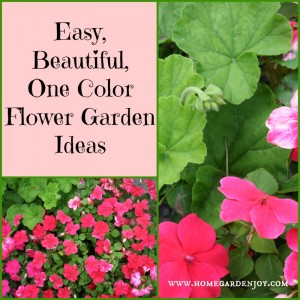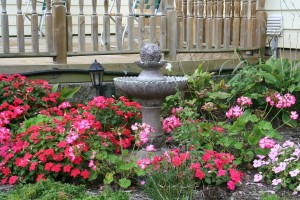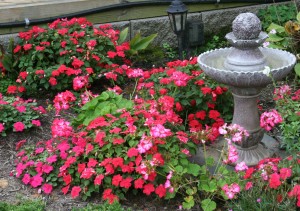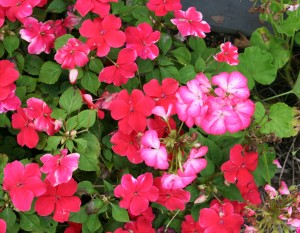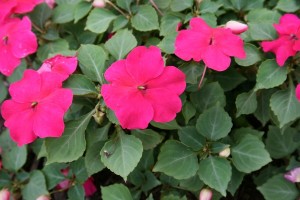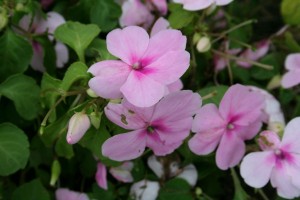This is an easy flower garden design idea that even the most design-challenged gardener can use to create beautiful flower beds. It’s called monochromatic or monochrome gardening. “Mono” of course means “one” and “chrome” refers to color. Monochromatic garden design means designing a garden around a single color palette. You choose different flowers but keep all of the flowers within the same color family, choosing shades, tints and hues from within the palette to celebrate a single color.
My garden is not monochromatic, but this year I experimented with the small garden next to my back deck. Sometimes I refer to it as the “fountain garden” because my small garden fountain sits in the middle of the garden.
Permanent Plants in this Garden
The back of the garden is planted with several perennials and bulbs; hosta, salvia and phlox are the perennial “backbones” of the garden, with daffodils, tulips and hyacinths blooming in the spring, and gladiolus in the summer.
I plant annuals in the central portion of the garden each year. I usually choose annuals that the deer love or that need extra TLC. Why? Because this garden is right next to the house. I’ve got an easily accessed water supply from the garden hose hooked up right next to the garden, and I can see the garden each day from my kitchen windows. It’s right next to the house, so the deer don’t venture into the garden to nibble at the plants, and I can grow moisture and shade-loving plants in this cool, shady nook.
My Monochrome Garden: Pretty In Pink
I love geraniums, impatiens and petunias, so this year I decided to stick with these three summer-blooming flowers. Although red is my favorite color, I like how pink seems to glow in the summer evening light. Impatiens especially seem to glow with an almost phosphorescent light; I love how they look in the shade.
Around the fountain in the pictures, I planted:
- Light pink impatiens (2 plants)
- Medium pink geraniums (4)
- Dark pink impatiens (8 plants)
And that was it!
Here are the results of my experiment with monochromatic plantings. I love how the green leaves are also different shades of green, with the impatiens featuring darker green leaves and the geraniums a more lime color.
You can experiment with blue, purple, yellow, orange, red, even white to create monochromatic gardens. The secret, of course, is to plant different flowers of the same color.
Easy Monochromatic Flower Garden Ideas
The following suggestions are for temperature gardening zones (5-8) and are general suggestions only. Talk to your local garden center staff or Cooperative Extension office for specific suggestions. I tried to group perennials together with various blooming times so that the garden shows some perennial color from late spring through fall.
Sunny Areas, Yellow/Orange Palette
Perennials:
- Gaillardia
- Rudbeckia (black-eyed Susan)
- Daylilies
- Chrysanthemums
- Vines such as trumpet vine, honeysuckle (both can be invasive in some areas)
Annuals:
- Yellow pansies
- Calendula
- Portulaca
- Marigolds
Bulbs:
- Tulips
- Crocus
- Hyacinth
- Daffodils
Sunny Areas, Blue/Purple Palette
Perennials
- Salvia
- Nepeta (cat mint)
- Platycodon (balloon flower)
- Asters
- Vines such as clematis
Annuals
- Purple pansies
- Verbena
- Petunias
- Vines such as morning glories
Bulbs
- Tulips
- Crocus
- Glory of the Snow
- Grape hyacinth
- Purple hyacinth
- Gladiolus
Shady or Partial Shade Areas, Pink Palette
Perennials
- Astilbe
- Heucheria (Coral Bells)
- Hosta
- Vines such as clematis
Annuals
- Impatiens
- Petunias
- Geraniums
Bulbs:
- Hyacinth
- Tulips
Note: Hyacinth and tulips need at last partial sun. However, many shady areas are sunny in the spring until the deciduous trees leaf out. If your shady area is sunny in the spring but gets shady as the trees grow leaves, then you can plant sun-loving bulbs which bloom early, follow by shade-loving plants that bloom later in the season.
White Palette, Sunny Areas
Perennials
- Daisies
- Platycodon (balloon flower)
- Chrysanthemums
Annuals:
- Pansies
- Petunias
- Stocks
- Vines such as Moonvine
Bulbs:
- Tulips
- Hyacinths
- Crocus
- Summer-blooming white gladiolus
A major figure in the world of garden design was Gertrude Jekyll. She designed a white border that was quite famous, and was a proponent of using color schemes in the garden. Below is one of her books on using color in the garden. This is an Amazon affiliate link, so if you click it to shop or buy the book, I earn a little commission. It does not affect your costs.
Do you plant a monochrome garden? Would you try it? Leave your comments below.

